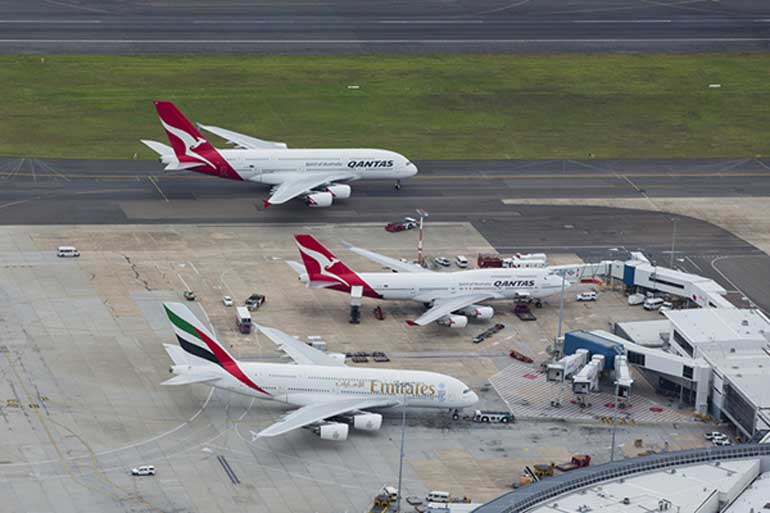Saturday Jan 11, 2025
Saturday Jan 11, 2025
Monday, 12 October 2015 00:00 - - {{hitsCtrl.values.hits}}

Australian carrier Qantas is looking at ways it can expand its partnership with Emirates Airline, such as on new routes into Australia, its chief executive told Reuters on Thursday.
“We would like to see Emirates flying into more Australian destinations, which they’re keen on,” Alan Joyce said on the sidelines of the Capa World Aviation Summit in Helsinki.
“We think it’s working so well, there has to be more we can do,” he said. Qantas will also discuss with Emirates the best way to use slots at London Heathrow when two slots leased to British Airways revert to Qantas at the end of 2017.
The Australian carrier agreed to an alliance with Emirates in 2012 as part of its turnaround, switching its hub for European flights to Dubai – Emirates’ base – from Singapore and coordinating on pricing, sales and schedules.
Under Joyce’s strategy to cut costs, trim capacity and raise fares, Qantas announced a return to full-year profit in August.
Qantas has ordered eight 787-9 Dreamliner jets and has options for a further 15, plus other purchase rights. The planes have the range to reach Europe, Joyce said.
“It opens up European markets direct from Australia so that’s an exciting opportunity in the long-term.” However, the Dreamliners will first be used to replace 747s currently serving South Africa and routes to South and North America, Joyce said. A decision on whether to exercise the options, which would be for deliveries from 2019, will be made only if a business case for routes can be made.
Australia’s decade-long mining boom has turned to bust as demand for mineral commodities to fuel industrial expansion in China has waned.
Joyce said he expects the downturn in the resources sector, which accounts for 12% of its corporate traffic, to last for another 18 to 24 months.
To combat the downturn, Qantas has been using smaller aircraft from its charter business on routes serving the mining industry in the west of Australia and putting the more expensive aircraft on routes to Singapore and the eastern coast of Australia, where the financial and infrastructure industries are performing better.
The resources decline has seen the Australian dollar weaken but Joyce said he was happy with the current exchange rate because it was making the country’s manufacturing sector more competitive and attracting more tourists. – Reuters
Reuters: Emirates airlines indicated last week that it won’t be announcing any big orders at next month’s Dubai Airshow and said it wouldn’t make a decision this year on whether to purchase Airbus A350 or Boeing 787 twin-aisle jets.
Tim Clark, the airline’s president, asked at an event whether any orders were likely to be announced at the air show which runs 8-12 November, said the carrier was still taking delivery of planes announced at the last show in 2013.
“We’re still running the program we signed for (in 2013), we’ve got aircraft coming in as you know,” Clark told reporters.
“The Xs (777s) come in late-2018 and 2019. That’s enough for the time being,” he said.
Dubai’s flagship carrier has said it is looking at an order for 50 to 70 twin-aisle jets – with the main competitors being the Airbus A350-900 and Boeing’s new 787-10, a stretched Dreamliner.
“We’re looking at both of them ... we’ve got a good comparison opportunity,” Clark, told reporters on the sidelines of an aviation security conference hosted by the airline.
“Now we’re going to the manufacturers about the numbers that we need and the prices they’re prepared to offer. We haven’t got there in detail yet,” he said.
Emirates has received the needed performance data on the A350 as well as from Boeing’s 787-8 and 787-9, variants on the Dreamliner which are already in service, Clark said.
However, he raised doubts about the 787-10’s ability to carry heavy passenger and cargo loads to distances beyond eight hours due to its performance in hot climates – an issue for a Gulf-based airline.
“It (787-10) doesn’t have the capability of lifting the payload to distances that we would want beyond about eight hours,” Clark said.
The A350 meanwhile, can fly for about 14 hours, Clark said, although he also said 85% of Emirates’ flights do not exceed eight hours.
Many analysts had expected Emirates to announce a big order at its home air show next month as it has done previously.
At the show in 2013, it placed a record-breaking order for 150 Boeing 777x, valued at $76 billion at list price, and added another 50 A380 jumbo jets to an existing order for 90 of the Airbus aircraft in a deal valued at $ 21.4 billion at list price.
The carrier, which is based at Dubai International airport, is having to make difficult purchase decisions due to space constraints at the airport.
Emirates, which is pushing Airbus to make a stretched and re-engined version of the A380, is unlikely to shift its base to the new airport for another decade.